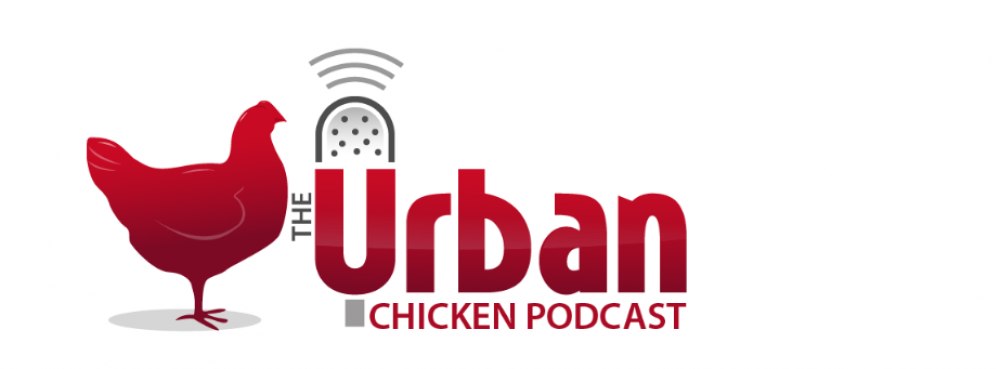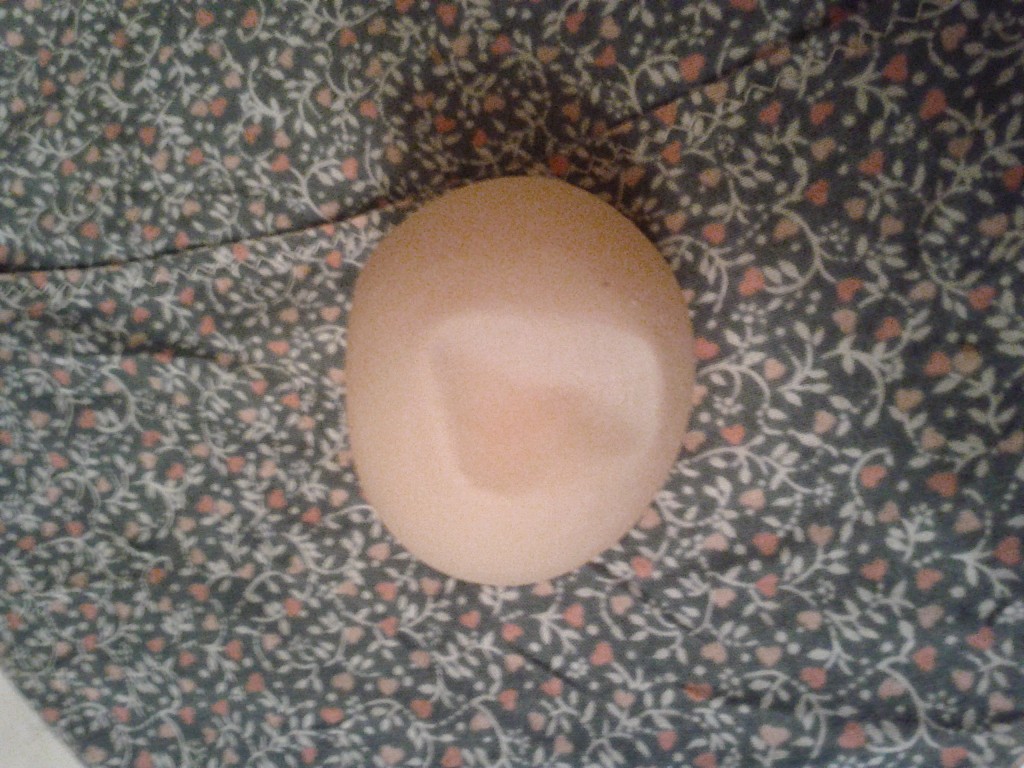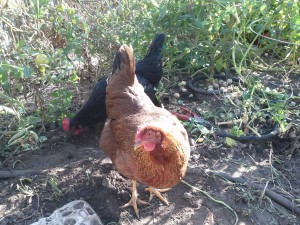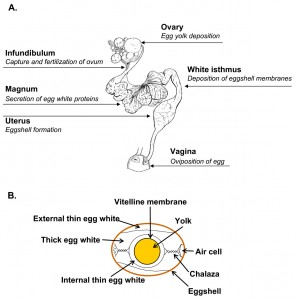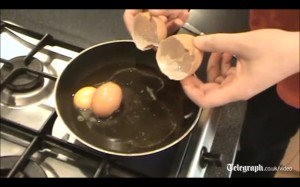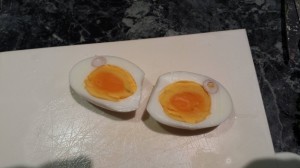Eggs: they’re colorful; they’re delicious; and they’re supposed be the hard-shelled and oval. However, sometimes they’re not shaped and formed as they ought to be. Today, on the Urban Chicken Podcast we are discussing why chickens sometimes lay soft-shelled or even shell-less eggs. We will also consider what you the chicken owner can do to try to remedy any soft/shell-less egg issues in your flock.
My beautiful and very sweet tempered Welsummer hen, Beatrix has never laid me a proper egg. She rarely lays and when she does it is always either soft-shelled or even completely lacking a shell. She usually leaves these disturbing egg monstrosities at the bottom of the coop and not in the nesting box. Consequently, I have been researching why is she laying me icky eggs. Today I am going to share all that I have learned through my research.
HOW A CHICKEN MAKES AN EGG
To understand how an egg might be formed improperly, we should first understand how a chicken makes an egg. Here is the egg-making process all hens go through. As mentioned in UCP episode 018, all hens are born with two ovaries, but only the left one is active in the forming of ova (i.e. eggs). The right ovary is not fully formed and lays dormant. Once a day, the hen’s ovary releases a single ovum , though this is called an “oocyte” in chickens, which then enters the oviduct. The oviduct is a long tube that carries eggs from the ovary to the cloaca, which is the opening at the rear of a chicken from which she lays her daily eggs. The oviduct itself has distinct segments that perform different duties.
When the freshly released oocyte enters the oviduct, it consists of just the yolk in a fully formed egg. This yolk is initially enters the segment of the oviduct known as the “magnum.” While traveling through the magnum, the yolk (oocyte) is covered with albumen (i.e. the protein whites of an egg). The egg then continues traveling down the oviduct from the magnum to the “isthmus” section. It is in the isthmus that the eggshell membranes are deposited over the yolk and whites. The egg then travels from the isthmus to the uterus (also known as the shell gland). Over a period of time ranging from nineteen to twenty-six hours, the egg will remain in the uterus while the calcium carbonate shell is deposited over the egg. The egg finally leaves the uterus section of the oviduct to journey the final segment of the oviduct to the cloaca. Just before an egg is laid, the protective bloom is deposited onto the outer shell of the egg (for more information on egg blooms see: UCP episode 013).
AN EGG INSIDE AN EGG PHENOMENON
The explanation above is how an egg is formed in a nutshell. In rare cases, while in the process of producing an egg, the hen can experience a “counter-peristalsis contraction.” A counter-peristalsis contraction is when a second egg is released by the ovary before the first egg in the system is laid. The counter-peristalsis contraction causes the first egg traveling through the oviduct to reverse its course and be pushed back up to the top of the oviduct. As a consequence, the first egg (i.e. the lower one in the oviduct that reversed course) is typically sucked up inside of the second egg. The second egg then travels down the oviduct and has albumen and a shell deposited over it and first egg, which is now joined with it. This creates a very large egg for your poor hen to lay. Poor Chickie-choo! When you crack open such an egg, there is normal yolk and whites and also a whole other fully formed egg inside (shell and all).
The recent TINY egg found inside a regular-sized egg in Britain, was also caused by a counter-peristalsis contraction. However, in this case the oocyte that was released in the first egg (the one that reversed course in the oviduct) was tiny because the ovary had released an egg out of order. Usually hens ovulate daily in order of size – laying the largest oocyte first. The hen’s ovary is simultaneously forming smaller oocytes at the same time. From time to time, a smaller, not fully formed oocyte jumps the queue. In case of the British man who found the tiny egg inside a normal-sized egg – that is what happened.
SOFT-SHELLED AND SHELL-LESS EGGS
Now, let’s consider the causes of soft or shell-less eggs. Soft shelled eggs have sort of a leathery feel to them.
Beatrix’s Leathery Soft-Shelled Egg (No Narration in Video):
Shell-less eggs are different than soft-shelled eggs. They simply have the membrane but no shell at all, which makes them much more fragile.
Beatrix’s Shell-less Egg (Video has Narration):
There are three common causes of soft/shell-less eggs. The first and most common cause is a lack of calcium. It takes up a lot of calcium to form a new eggshell each and every day. If you are starting to get soft/shell-less eggs try adding crushed oyster shells or baked, crushed eggshells into your flock’s feed. That should provide them with the calcium supplement they need.
Dietary imbalance is the second most common cause of soft/shell-less eggs. It is really tempting to treat your flock of chickens like a mini herd of goats – living garbage disposals. Chickens love treats. If you give them enough treats they will NOT eat their layers feed, which is balanced with protein and calcium for their diet. If you’re unsure what is causing the soft/shell-less eggs then you should consider cutting back or out entirely all treats from your flock’s daily food. Remember, ideally your hens should never be eating more than about 20-25% treats in their diet.
The third most common cause of soft/shell-less eggs is bullying. Some flocks suffer from terrible henpecking. The tormented, subordinate bird will be not only emotionally, but also physically affected by her constant attacks. A henpecked bird often either lays misshaped eggs or even stops laying all together due to the stress in her life. To a certain degree you have to let the chickens work things out themselves, but if the bullying is vicious and on-going you should take measures to intervene. If the situation is bad enough, consider using beak bits to stop the henpecking.
Some less common causes of soft/shell-less eggs include: parasites, disease and genetics. Lice and mite infestations will stress your bird and the stress will often prevent her laying normal eggs or laying at all. You can find out more regarding poultry lice and mites and their treatments in UCP episode 014.
Avian diseases causing soft/shell-less eggs are potentially deadly for your flock and should be treated seriously. Some examples are: respiratory infections, avian flu, egg drop syndrome, Newcastle’s disease, etc. For the most part there are no effective treatments for these diseases and the illness will either kill your bird or clear up. A hen that was once ill with these sorts of diseases may not be as hardy a layer afterwards.
Lastly, genetic defects can sometimes cause soft/shell-less eggs. A hen simply might have a defective uterus and be unable to properly deposit a shell over an egg. You should be sure to eliminate that hen from your breeding stock to try to remove the defect from your genetic pool. Some sources would suggest culling (i.e. killing) these genetically defective birds. However, in a backyard flock of pet hens that might be more than what you could stomach doing. I suspect that my poor Beatrix Chicken is genetically lacking and that is why she cannot or does not lay me proper eggs. I could never kill her simply because she is not pulling her weight in the egg laying department though.
CHICKEN NEWS:
- Huffington Post – World Egg Day October 11, 2013 LINK
- Buzzfeed – Tiny Egg Found Inside Other Egg ARTICLE
MAIN SEGMENT:
- Poultrykeeper.com – Thin or Missing Eggshells LINK
- Chickenvet – Egg-laying Issues LINK
- Hencam – Soft shelled Eggs LINK
- BLP Books – Egg Problems ARTICLE
- Soft Shelled Chicken Egg VIDEO
- Another Soft Shelled Chicken Egg VIDEO
- Poultry Site – Egg Issues CHART
- Poultry Site – Egg Drop Syndrome ARTICLE
- Hencam – Thin Eggshells with Older Hens LINK
- Avianweb – Soft-shell and Misshapen Eggs LINK
- Poultry Q/A – Soft shelled Chicken Eggs Q&A LINK
- Alltech – Poster About Egg Quality CHART
SALLY’S SIDENOTES:
- Contest for Lauren Sheuer’s Book, “Once Upon A Flock:Life With My Soulful Chickens” LINK To CONTEST
- Cackle Hatchery – Photo Contest Links HERE, HERE and HERE
Podcast: Play in new window | Download | Embed
Subscribe: Apple Podcasts | RSS
